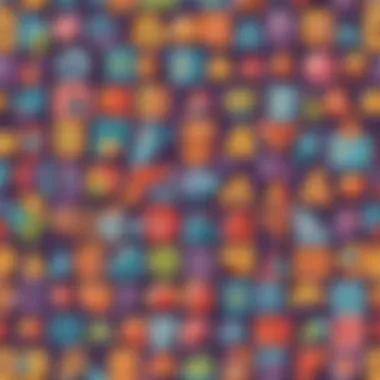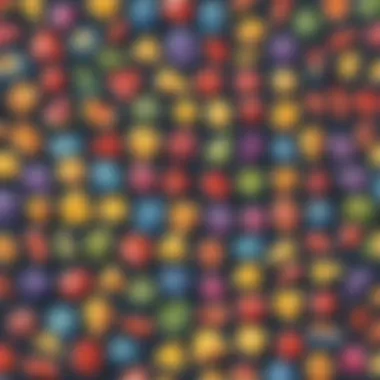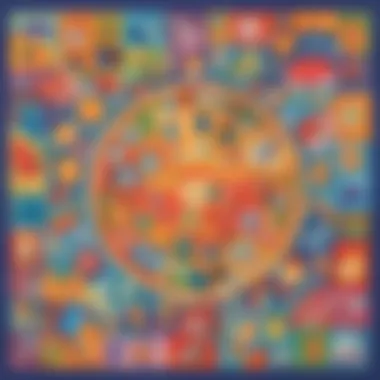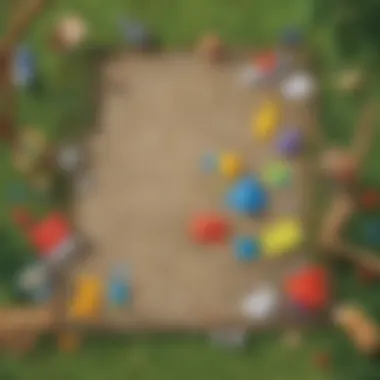Engage Kindergarteners with Exciting Shapes Exploratory Activities


Fun Activities Ideas
Indoor Activities
Indoor activities offer a cozy setting for kindergarteners to explore shapes amid familiar surroundings. From creating geometric collages with colored papers to building shape towers with blocks, the indoors provide a nurturing space for children to enhance their spatial awareness and critical thinking skills. Through imaginative play and structured games, kids can immerse themselves in a world of shapes and patterns, fostering a deeper connection to geometrical concepts.
Outdoor Adventures
Venturing outdoors adds new dimensions to the exploration of shapes for young learners. Excursions to the park can evolve into shape scavenger hunts, where children seek out circles, squares, and triangles in nature's playground. By incorporating outdoor play structures such as slides and swings, kids can interact with shapes in a real-world context, facilitating a seamless blend of learning and recreation. Outdoor adventures not only stimulate physical activity but also ignite a sense of wonder and discovery in the realm of shapes.
Arts and Crafts
Engaging in arts and crafts activities elevates the experience of learning shapes for kindergarteners. From crafting DIY 3D shapes using materials like clay and cardboard to painting geometric patterns on canvas, the realm of artistic expression offers a multifaceted approach to shape exploration. By fostering creativity and fine motor skills, arts and crafts enable children to transform abstract concepts of shapes into tangible and visually appealing creations, igniting their imaginative spark and passion for geometry.
Science Experiments
Delving into science experiments provides a hands-on and immersive way for children to grasp abstract geometrical concepts. Through experiments like building shape structures with marshmallows and toothpicks or exploring the properties of geometric solids with sensory bins, kids can engage with shapes in a dynamic and interactive manner. These science activities not only enhance observation and deductive reasoning skills but also cultivate a scientific mindset that nurtures curiosity and a deeper understanding of shapes in the world around them.
Cooking and Baking
Incorporating shapes into cooking and baking activities infuses a delicious twist into shape exploration for kindergarteners. From cutting sandwiches into triangles to decorating cookies with circular patterns, the kitchen transforms into a culinary classroom for children to experiment with shapes in a flavorsome way. By measuring ingredients, following recipes, and identifying shapes in culinary creations, kids can develop mathematical skills, sensory awareness, and an appreciation for the art of cooking, making shape learning a delectable and enriching experience.
Introduction


Overview of Shapes Activities
The Importance of Learning Shapes at a Young Age nurtures fundamental cognitive abilities critical for a child's intellectual growth. Strategic incorporation of shape learning cultivates creativity and enhances visual comprehension. This approach assists in honing a child's perceptual skills and lays a strong foundation for advanced concepts.
Benefits of Incorporating Shapes Activities in the Kindergarten Curriculum extend beyond academic achievements. By integrating shapes into the curriculum, educators promote holistic development in children. From enhancing problem-solving skills to fostering spatial reasoning, shape activities offer a comprehensive learning experience. Kindergarteners engaging in such activities display improved concentration, analytical thinking, and creative expression.
Hands-On Shape Crafts
In this section, we delve into the significance of engaging children in Hands-On Shape Crafts within the context of kindergarten activities. Hands-On Shape Crafts play a crucial role in nurturing early childhood development by fostering creativity, fine motor skills, and shape recognition. By actively engaging in crafts such as creating shape collages and building with geometric shapes, children not only enhance their artistic abilities but also develop a deeper understanding of various shapes and their properties. Moreover, Hands-On Shape Crafts provide a tactile learning experience that aids in solidifying cognitive connections and promoting spatial awareness.
Creating Shape Collages
Materials Needed for Shape Collages
The materials required for shape collages are fundamental to the creative process and learning outcomes associated with this activity. Common materials include colored paper, scissors, glue, and a variety of pre-cut shapes such as circles, squares, triangles, and more. These materials are essential in enabling children to explore shape combinations, patterns, and spatial arrangements. By utilizing diverse shapes and colors, children can express their artistic ideas while simultaneously improving their shape recognition skills in an interactive and hands-on manner. The versatility of materials for shape collages allows for endless possibilities for creativity and customization, making this activity a popular choice for engaging young learners.
Step-by-Step Guide to Making a Shape Collage
The step-by-step guide for making a shape collage serves as a roadmap for children to channel their creativity effectively. Beginning with selecting a base for the collage, such as a piece of cardboard or paper, children are then encouraged to choose and arrange shapes to form a cohesive design. This process promotes problem-solving skills, critical thinking, and spatial reasoning as children decide on shape placement and composition. Guided by imagination and creativity, children glue the shapes onto the base to bring their collage to life. Following a systematic approach enhances children's organizational skills and attention to detail, contributing to the overall success of their shape collage creations.
Interactive Shape Games
Interactive Shape Games play a vital role in this comprehensive exploration of Shapes Activities for Kindergarten. These games are meticulously designed to engage young minds and foster a deep understanding of geometric shapes in a dynamic and immersive manner. By integrating hands-on interactive experiences, children can grasp abstract concepts more effectively, promoting cognitive development and spatial reasoning skills. The interactive nature of these games allows for active participation, enhancing children's problem-solving abilities and strategic thinking. Moreover, Interactive Shape Games serve as a bridge between theoretical learning and practical application, making the educational process more engaging and memorable.
Shape Sorting Game


Instructions for Playing a Shape Sorting Game
The Instructions for Playing a Shape Sorting Game are fundamental to the success of this activity in promoting shape recognition and classification among kindergarteners. Clear and concise instructions help children understand the rules of the game, encouraging active participation and independent thinking. By providing step-by-step guidance on how to sort shapes based on specific attributes such as size, color, and orientation, this game cultivates critical thinking and decision-making skills. The visual and tactile components of the game further enhance sensory learning and fine motor skills development, making it a versatile and effective educational tool tailored for young learners.
Variations to Make the Game More Challenging
Introducing Variations to Make the Game More Challenging adds an element of excitement and innovation to the Shape Sorting Game. By incorporating different levels of difficulty or introducing time constraints, educators can adapt the game to suit varying skill levels and keep children motivated. These variations stimulate cognitive flexibility and adaptive problem-solving, encouraging students to think creatively and apply different strategies. While challenging, these variations provide opportunities for personal growth and skill refinement, fostering a growth mindset and resilience in the face of challenges.
Shape Hunt Adventure
Setting Up a Shape Hunt
Setting Up a Shape Hunt sets the stage for an immersive and interactive learning experience centered around shape recognition and exploration. Creating a stimulating environment where children can search for shapes in their surroundings instills a sense of curiosity and wonder, making learning enjoyable and meaningful. By strategically placing shape clues in designated areas, educators can encourage observational skills and attention to detail, fostering a keen eye for geometric patterns and forms.
Ideas for Incorporating Learning Objectives in the Game
Incorporating Learning Objectives in the Shape Hunt Adventure is essential for aligning the game with educational goals and outcomes. By linking shape recognition with specific learning objectives such as identifying patterns or distinguishing between geometric shapes, educators can enhance the educational value of the activity. Furthermore, integrating thematic elements or storytelling into the game provides context and relevance, engaging children in a holistic learning experience that transcends mere shape recognition. These intentional design choices make the Shape Hunt Adventure a multifaceted and enriching learning opportunity for young learners.
Educational Shape Activities
In the realm of kindergarten education, Educational Shape Activities emerge as crucial components in cultivating young minds. These activities serve as potent tools for sharpening cognitive abilities, enhancing spatial awareness, and fostering critical thinking from an early age. By delving into the world of shapes, children develop a foundational understanding that transcends mere geometry; they learn to observe patterns, analyze spatial relationships, and problem-solve creatively. The integration of Educational Shape Activities into the curriculum not only nurtures a child's academic growth but also hones their visual and analytical faculties. Through hands-on experiences with shapes, children embark on a journey of exploration, discovery, and cognitive development, laying a robust foundation for future learning endeavors.
Pattern Recognition Exercises


Pattern Worksheets for Shape Recognition
Pattern Worksheets for Shape Recognition stand as pillars of educational efficacy, offering structured exercises that prompt children to identify, analyze, and replicate patterns using an array of geometric shapes. These worksheets play a pivotal role in refining a child's perceptual skills, honing their ability to discern visual sequences, and fostering pattern recognition acumen. The interactive nature of these worksheets captivates young learners, stimulating their minds while instilling a sense of order and logic. By engaging with Pattern Worksheets for Shape Recognition, children not only enrich their understanding of shapes but also fortify their cognitive agility, preparing them for advanced learning challenges. The versatility of these worksheets allows educators to tailor activities to meet individual learning needs, ensuring a personalized and effective learning experience.
Interactive Pattern Recognition Activities
Interactive Pattern Recognition Activities inject an element of dynamism and engagement into the process of shape comprehension. These activities transcend traditional rote learning methods by incorporating gamified elements, puzzles, and collaborative tasks that immerse children in a stimulating and interactive learning environment. By participating in these activities, children embark on a hands-on journey of exploration, experimentation, and discovery, honing their ability to recognize, predict, and create patterns with confidence and flair. The interactive nature of these activities fosters a sense of playfulness and discovery, instilling a love for learning and problem-solving. Through Interactive Pattern Recognition Activities, children not only reinforce their grasp of shapes but also cultivate essential skills such as critical thinking, spatial reasoning, and logical deduction, setting a solid foundation for intellectual growth.
Shape Bingo
Creating Customized Shape Bingo Cards
Creating Customized Shape Bingo Cards offers a tailor-made approach to shape learning, allowing educators to design bingo cards that align with specific learning objectives and cater to individual student needs. These customized cards introduce an element of personalization and adaptability, ensuring that every child receives a targeted learning experience that suits their developmental stage and learning pace. By incorporating shapes into the framework of a classic bingo game, educators can captivate young learners, making the process of shape recognition engaging, competitive, and fun. The flexibility of Creating Customized Shape Bingo Cards empowers educators to craft activities that resonate with diverse learning styles, fostering inclusivity and engagement in the classroom.
Tips for Making Shape Bingo Educational and Engaging
Tips for Making Shape Bingo Educational and Engaging serve as guiding principles for educators looking to maximize the learning potential of this classic game. By infusing educational content, interactive elements, and thematic variations into the traditional bingo format, educators can transform a simple game into a dynamic learning experience that resonates with young minds. Incorporating shape-related trivia, challenges, and collaborative tasks can enrich the gameplay experience, encouraging active participation, critical thinking, and knowledge retention. By leveraging the intrinsic appeal of bingo with educational twists, educators can create a stimulating and enriching environment that nurtures a love for shapes, learning, and intellectual discovery among young learners.
Conclusion
Shapes activities for kindergarteners are not merely about play; they serve as a foundational tool for cognitive development. By immersing children in interactive and educational experiences focused on shapes, we pave the way for enhanced spatial reasoning, problem-solving skills, and creativity. Through this article, we have uncovered a plethora of engaging activities that can revolutionize the learning journey of young minds.
Enhancing Learning Through Shapes
Reflecting on the Benefits of Shapes Activities for Kindergarteners
Within the realm of shapes activities for kindergarteners, reflecting on the benefits showcases how these engagements transcend mere aesthetics. It is the cornerstone for instilling critical thinking, visual-spatial awareness, and mathematical reasoning in children at a crucial developmental stage. The focus on shape activities fosters a deep understanding that extends far beyond identifying circles and squares but opens doors to analytical thinking and cognitive growth.
Ideas for Continued Exploration of Shapes Beyond Kindergarten
As we consider the journey beyond kindergarten, the exploration of shapes becomes a catalyst for sustained learning. The concepts absorbed in early years serve as a springboard for advanced geometrical understanding, design principles, and even technological applications. By encouraging continued exploration in various forms, such as 3D modeling, architecture, or even art and design, we create a roadmap for lifelong learning that transcends academic boundaries and fosters a holistic approach to shape comprehension.



